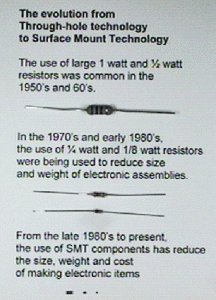-written by Guy Corsey, Dataram Memory Blog Team Member
Remember when Dick Tracy would speak to his Police chief through his wrist watch? I always thought of how cool it would to be able to do that.
Well, with the creation of Surface Mount Technology, what I thought was so cool has become reality. Surface Mount Technology (SMT) had its beginnings in the 1960s, largely used by NASA in guidance systems of unmanned vehicles initially, but on a very small scale. During that time through-hole technology was still being used as the main manufacturing technology in electronic manufacturing. Through-hole technology was robust, reliable and people were comfortable with it because it had been around for some time—since the beginning of the printed circuit board. On the other hand however, it was big, bulky and in many cases, very heavy.
So, in “the 60s” IBM began to use the same components from the through-hole era and put them on to printed circuit boards that had no holes for components to go through. They bent the leads of the components to be able to sit flat on the surface of the printed circuit boards. That’s where the name Surface Mount was derived from—components sitting on the surface. The experimental stage went on for some time. Developing components that would reduce cost and make the items smaller and lighter was the focus of engineers. The old reliable through-hole technology held its ground during the 1970s and into the early 1980s. In the background, SMT was gaining recognition. It was being used more and more in commercial electronics by the mid 1980s. The component manufacturers were able to make components more reliable. More types of components had been developed to take the place of the old through-hole components and the Integrated Circuit had come a long way since its development in the 1950s.
Today there is a mass number of different SMT components. Some are so small you can barely see them with the naked eye. With the growth of SMT equipment placing these components, they can be placed with extreme accuracy, speed and repeatability. The components can be picked up by the equipment, measured and inspected and placed on a PCB in less then a tenth of a second, allowing hundreds of thousands of components to be placed in an hour.
Rarely is through-hole technology being used in today’s commercial electronics. The thirst for commercial electronics by consumers contently being on the rise with mobile media, home owner appliances, television and most any other type of electronic device. Surface Mount Technology will continue to grow for years to come. With Surface Mount Technology, the future is now.







